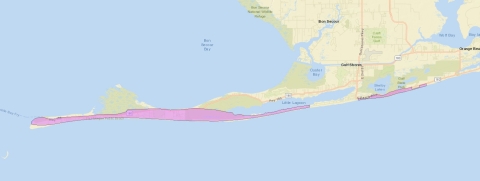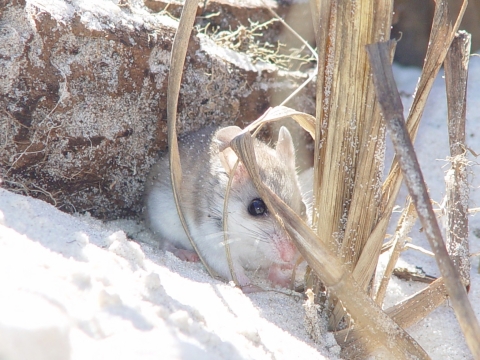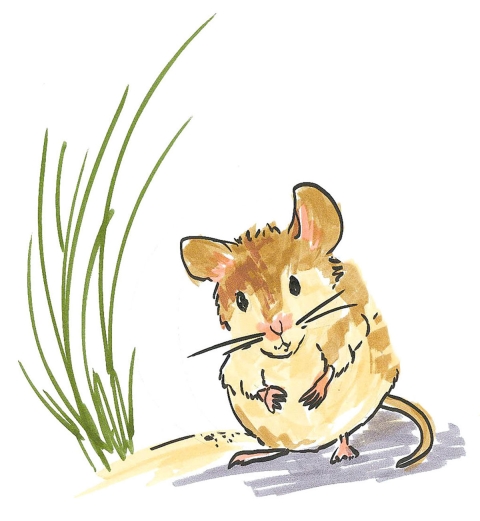If we were in a storybook, the final line might read: The little Alabama beach mouse, and the people in the beach house lived happily ever after. Reality has more nuances. Yet, the lives of the people and the beach mouse are intertwined, in part through permitting.
Meet the Alabama Beach Mouse
Our story is set in the sand dunes along the Alabama coastline. The area appeals to a variety of people wanting to build a home or recreate on the beach. “One of the things that drew us to the area was that it was wild, and it wasn’t overbuilt…”, shared Michelle Garmon, a local homeowner.
But people aren’t the only ones with a home here.
Measuring only 4-5 inches (including the tail!), the Alabama beach mouse (Peromyscus polionotus ammobates) is an elusive neighbor with a light-colored coat that evolved over time to look like the reflecting sand. The mice live in the dunes on the beach and tend to stay out of human homes.
“It may be one of the tiniest creatures you’ve ever seen, but the role it plays is huge,” described Garmon. The mice move seeds around, some of which are forgotten or lost. The uneaten seeds then grow into plants that stabilize the dunes and defend against storms and hurricanes.
To conserve the mouse and the critical role it plays in protecting this landscape, the Alabama beach mouse was listed on the Endangered Species Act. Activities or actions that impact the beach mouse therefore require a permit.
A Balance Between Construction and Conservation
Specifically, construction in beach mouse habitat requires an incidental take permit (3-200-56 Incidental Take Permits Associated with a Habitat Conservation Plan).
“The emphasis of our permit is to build in concert with nature”, described Bill Lynn, a U.S. Fish and Wildlife Service Biologist. He added: “The permit is a balance between the interests of private landowners and the wildlife. If it weren’t for the permitting program, then the Alabama beach mouse would be extinct today.”
For those seeking to build in this delicate landscape, the process kicks off with a pre-consultation meeting.
Potential applicants must submit a habitat conservation plan (HCP). The HCP is a planning document that outlines how to balance economic use and wildlife conservation by minimizing and mitigating the impacts of activities on the beach mouse. For example, applicants may propose using native plants in the landscaping or fencing that helps build sand dunes. Permittees also agree to prevent household cats from roaming free.
John Brett, with Brett/Robinson Real Estate, builds in the area and was first introduced to the beach mouse in the 1990s. For him, “The keyword is balance. There’s a high probability that mouse habitat is there and that’s something you have to address upfront. We planned for it…and our homeowners are going to love that additional 75 feet of beach front that they get to use.”
Additional documentation needed for the application can include historical surveys, a proposed site plan, and even a plan for landscaping, so it’s important that potential applicants are prepared. The pre-consultation meeting is also significant because an application for the incidental take permit triggers a strict timeline.
Brett added, “We work with U.S. Fish and Wildlife to preserve the natural resources that we have along this beautiful Gulf Coast. We know that the Service is not there to prohibit us.”
Ready to Apply? Go online.
Applicants previously had to go through the process by mail, but in 2020, the U.S. Fish and Wildlife Service launched ePermits as its online permitting website. The move to online was part of an effort to modernize and streamline permitting across the agency.
Paper applications are still available, but the online option helps the application process go more smoothly. The permit processor “opens” the online application in ePermits when a potential applicant is ready to submit the documentation and pay the associated fees.
In addition to being a homeowner in the area, Michelle Garmon is also an independent consultant for several builders. She has applied for an incidental take permit many times.
In her experience, “Time is of the essence with these things. As you know, people want to get their houses built and get to their happy place. [The ePermits system] is so much above the old paper forms…people were just so overwhelmed…and having it online, which you know the whole world is moving to, I just think it's made it more efficient.”
She further shared: “I’ve been able to follow the process since the first rollout of ePermits, and you can tell that the government is trying to make it easier. With the online system, it tracks where your application is. It makes [the process] more transparent as to what’s happening with your application. Before it was mail and wait. Now you have confirmation that your submission is in.”
When all documentation is in order, Garmon can prepare an application in about 30 minutes from start to finish. “Going into this, I was told [applying for a permit] was the hardest process…and honestly, if you learn the parameters and stay within them, it’s not hard at all,” she added.
Finding a Happy Ending
Processing of the incidental take permit can take some time, but once issued, the permit is good for 50 years. “We’re in a hurricane prone environment, so at one point or another damage will come to their homes, and since our permits are done in 50-year increments, they won’t have to consult again for getting the repairs they need,” explained Lynn.
Similarly, the protections offered to the beach mouse from the permitting process ensure that it able to co-exist with many generations of people to come. “It’s an investment to build a house so why not protect one of the species that helps protect your house during a storm” said Garmon.
Some final advice for new applicants:
- Start early and reach out to your local U.S. Fish and Wildlife Service office for help.
- Plan smart, remember to build in the costs upfront, and be mindful of other requirements needed to build the home.
Last but not least, those seeking to build aren’t alone. “Sometimes a builder might make a mistake, and we’ll work with folks to get the necessary corrections,” shared Lynn. There is also a Help Desk in ePermits to assist applicants and permittees with questions.
With the permit in place, the beach mouse and the people in the beach house can grow old together in their respective homes.
Additional Resources
For more information about the incidental take permit, habitat conservation plans, and the Alabama beach mouse, check out the following resources:










